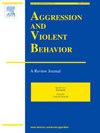早期生活铅暴露是青年人攻击性和暴力行为的危险因素:一项系统综述
IF 3.4
2区 心理学
Q1 CRIMINOLOGY & PENOLOGY
引用次数: 0
摘要
这篇综述的目的是综合个人层面的证据,证明早期生活铅暴露与年轻人的攻击性或暴力行为之间的关系。我们在2019年9月19日至10月30日期间对17个电子数据库进行了综合检索,并于2024年9月1日使用PubMed和Scopus数据库进行了更新。两名审稿人独立筛选所有记录和全文,从纳入的研究中提取数据,并使用纽卡斯尔渥太华工具评估偏倚风险。结果通过随机效应荟萃分析汇总。进行相关亚组分析和敏感性分析。2874项研究中有6项符合条件。所有研究都是在高收入国家进行的。不同研究对暴力的定义各不相同。血铅水平与暴力犯罪被捕或定罪的风险增加有关,每上升5 μg/dl,累积or为1.17 (95% CI: 1.10-1.23)。没有足够的数据进行剂量反应荟萃分析。尽管存在一些异质性,但研究一致报告了儿童时期接触铅与成年早期暴力行为之间的关联。需要更好的研究报告,特别是来自资源匮乏地区的研究报告来证实这些结果。环境铅控制可能有助于减少年轻人的攻击性和暴力行为。本文章由计算机程序翻译,如有差异,请以英文原文为准。
Early life lead exposure as a risk factor for aggressive and violent behaviour in young adults: A systematic review
This review was aimed at synthesising individual level evidence on the association between early life lead exposure and aggressive or violent behaviours in young adults.
We conducted comprehensive searches in 17 electronic databases between September 19th and October 30th, 2019 and updated this September 1st, 2024 using PubMed and Scopus databases. Two reviewers independently screened all records and full texts, extracted data from included studies, and assessed risk of bias using the Newcastle Ottawa tool. Results were pooled by random effects meta-analysis. Relevant subgroup and sensitivity analyses were carried out.
Six out of 2874 studies were found eligible. All were conducted in high income countries. The definition of violence varied across studies. Blood lead level was associated with an increased risk of arrest or conviction for violent crime with a pooled OR of 1.17 for each 5 μg/dl rise (95 % CI: 1.10–1.23). There was insufficient data to conduct a dose response meta-analysis.
Despite some heterogeneity, studies consistently reported an association between lead exposure in childhood and violent behaviour in young adulthood. Better reported studies, particularly from lower resourced settings, are needed to confirm these results. Environmental lead control may help to reduce aggressive and violent behaviour in young adults.
求助全文
通过发布文献求助,成功后即可免费获取论文全文。
去求助
来源期刊

Aggression and Violent Behavior
Multiple-
CiteScore
7.50
自引率
4.30%
发文量
63
期刊介绍:
Aggression and Violent Behavior, A Review Journal is a multidisciplinary journal that publishes substantive and integrative reviews, as well as summary reports of innovative ongoing clinical research programs on a wide range of topics germane to the field of aggression and violent behavior. Papers encompass a large variety of issues, populations, and domains, including homicide (serial, spree, and mass murder: sexual homicide), sexual deviance and assault (rape, serial rape, child molestation, paraphilias), child and youth violence (firesetting, gang violence, juvenile sexual offending), family violence (child physical and sexual abuse, child neglect, incest, spouse and elder abuse), genetic predispositions, and the physiological basis of aggression.
 求助内容:
求助内容: 应助结果提醒方式:
应助结果提醒方式:


